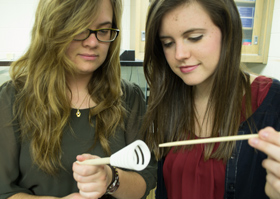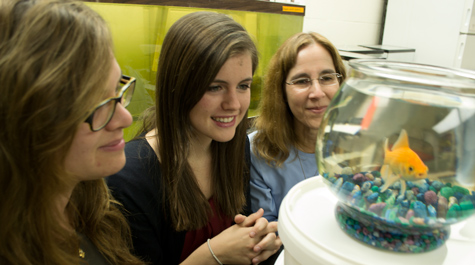A clog-resistant filtration system inspired by filter-feeding fish
The trouble with traditional filters is that they can’t do their job without clogging.
William & Mary ichthyologist Laurie Sanderson has a patent pending on a new type of filter that is designed to be clogless, or at least clog-resistant. The design is based on the fluid dynamics of filter-feeding fish. She is the author, along with several William & Mary undergraduates, of a paper presenting the novel fish filtration mechanisms in Nature Communications.
If you think about the filters that we use for making coffee or in furnaces, then Sanderson’s design hardly seems like a filter at all. Traditional filters work by screening the particulates out of the stream, and such filters need to be changed or cleaned. By comparison, Sanderson’s crossflow filtration design works on the principle of concentrating the particulates. It directs and recirculates fluid flow through a structure that looks familiar to anyone who has peered down a fish’s gullet. She calls the process cross-step filtration.
“I’m not suggesting we redesign our cars,” Sanderson said. “But, just by way of example: What if you could design an oil filter that instead of clogging and needing to be changed, it would send the stream of concentrated particles in one direction and the clean oil in another?”
She explained that while the process would not be practical in automotive oil filtration, crossflow filtration has a number of industrial applications and a cross-step process could be an improvement.
“There are many cases in industry in which we need to do something quite similar to what these filter-feeding fish are doing,” Sanderson said. “For example, in filtration of dairy products or fruit juices, we separate the hard parts — the fruit pulp, some of the congealed milk products — from the liquid.
“But here’s the situation today in industry,” she continued. “There is a filter, and that filter always clogs.”
Sanderson, a professor in William & Mary’s Department of Biology, says she spent 30 years thinking about fish mouths, trying to decipher the secrets of the clog-free fluid engineering going on inside what she calls the “black box” of filter-feeding fish. Many fish are filter feeders, she said, ranging from the whale shark — the largest fish swimming — down to menhaden, an important commercial species in Chesapeake Bay. Even goldfish are filter feeders.
She described goldfish as facultative filter feeders, fish that pump water into the mouth. By comparison, paddlefish and basking sharks are ram filter feeders, swimming through water with mouth agape. For Sanderson and her lab, the intake strategy is less important than what happens inside that black box, once the nutrient-laden fluid gets inside the fish mouth.
“When you look at a live fish, the water and the particles come into this black box, and then only water exits from the sides of the head,” she said. “So — water and particles go in the mouth. Then, something mysterious happens.”
Sanderson has used a number of scientific tools to probe the mystery of the filter-feeding black box.
“In the 1990s, I wondered what would happen if we could actually see into that black box, while the fish was feeding,” she said. “So we developed a technique to use a miniature fiber optic endoscope.”
She used an ear, nose and throat endoscope, less than a millimeter in diameter. “What we saw right away was that fish mouths weren’t filtering the way we thought they were,” Sanderson said. The understanding at the time, which persists in many texts today, was that the black box structure acted as a dead-end sieve like a spaghetti strainer or a coffee filter.
“That’s not what we saw with the endoscope,” she said. “We saw fluid and particles moving parallel to the filter. By the early 2000s, we had combined the endoscopy with computational fluid dynamics and realized that a diversity of fish species were using crossflow filtration. However, this just created another puzzle, because the fish crossflow filter never clogs, even though industrial crossflow filters always clog."
Sanderson’s co-authors on the Nature Communications paper, Erin Roberts ’16, Jill Lineburg ’16 and Hannah Brooks ’16, are W&M biology majors who joined the lab after the endoscopy and computational fluid dynamics work was done.
Roberts was the first of the three student co-authors to join the lab, starting her sophomore year. She helped Sanderson set up a flow tank in the basement of Millington for the next phase of the inquiry. The lab members studied preserved paddlefish in the flow tank — actual fish that left the taxidermist’s bench with mouths wide open, in feeding position.
The flow tank tests on preserved paddlefish complemented the design and 3-D printing of models of fish oral cavities; Roberts pointed out that the activities involved a significant amount of fluid dynamics and physics. Sanderson and the lab were trying to reverse-engineer the efficient filtering-funneling action used by fish.
The flow tank revealed more of how fluids behave as they go through the black box. Roberts explained that the tank allows the researchers to adjust the speed of the current while videocameras capture the movement of particles or dye through the preserved paddlefish or the 3-D models. Brine shrimp eggs are introduced to serve as particles.
Sanderson explained that the paddlefish and basking shark oral cavity consists of a set of bony structures known as branchial arches and the slots between them. The arches descend in size in a precise ratio as you go toward the back of the fish. Sanderson said a large portion of the black box’s function consists in how the arch/slot arrangements form “backward-facing steps,” creating a set of vortices, or recirculation regions, behind each step.
“The fish use these backward-facing steps and the resulting recirculation regions to manipulate and concentrate the particles,” she explained. The vortices also act as a “hydrodynamic tongue,” keeping the concentrated particles moving through the system — without clogging.
“This is something that potentially can be of use to industry,” Sanderson said. “Other filters use various kinds of knobs, baffles, ridges and corrugations. Engineers have been very clever in designing crossflow and other types of filters.”
Jason McDevitt, William & Mary’s director of technology transfer, notes that Sanderson’s design is different enough for it to get patent pending. Sanderson says that one advantage of her concept is that it could be used to design filters that would separate out particles in a controlled fashion, directing the particles in any desired direction.
“In theory, you could even separate different sizes out of the particle stream,” she said, “so it could send big particles in one direction and small particles in another direction."
Sanderson’s lab continues to work on other aspects of the problem of the black box. Brooks is studying paddlefish feeding in greater detail, while Lineburg is continuing studies with goldfish, training them to eat various types of particles. “We’re using videotapes to try to gain insight into the mechanisms in their oral cavity that allow them to process these particles,” Lineburg explained.
Sanderson says her cross-step process has the potential to be helpful across a number of applications and scales, from teeny filters of cell-sized particles to huge industrial pipes.
“These recirculation regions, behind any obstacle — but particularly a backward-facing step — form across basically any mechanical scale,” she said, including miniature blood pumps and even stent wires in arteries and other vessels."
McDevitt, whose job is to help William & Mary’s scientific discoveries make the transfer from lab bench to marketplace, says he’s optimistic about the potential of Sanderson’s work.
“This is a great example of a biomimetic technology that could have significant advantages over the current state-of-the-art,” McDevitt said. “We are particularly hopeful that this technology will be commercially developed and widely used for crossflow filtration.”
 Skip to main content
Skip to main content

